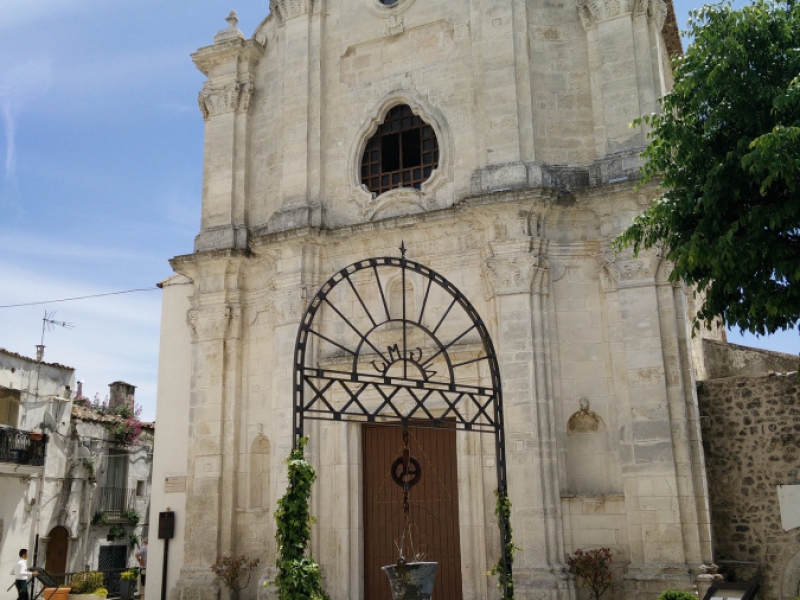
Its altitude is around 800 m. In practice it is a terrace overlooking the sea, from which you can admire the panorama of Manfredonia and the whole gulf.
Interesting is the visit to the Basilica of San Michele (Unesco Heritage), in front of which stands the Angevin Bell Tower with its characteristic geometric shape. The sanctuary of Monte S.Angelo is today a center of attraction and a privileged meeting point between the cultures of East and West and thousands of devout pilgrims go up to pray San Michele and receive a sign of his benevolence there on that sacred mountain, where, as Padre Pio of Pietralcin liked to repeat, "even trees pray".
Access from the atrium in front through two carved portals, continue along a staircase, thus reaching the lower floor where the actual sanctuary opens. Here opens a single-nave environment that ends with the cave. At the bottom of the cave is the altar and the marble statue of the Archangel; on the side there are other small chapels, including the Baroque Sacramento Chapel. Inside the Sanctuary there is the Stone Museum with finds between the VII and XV centuries, here some sculptures, Lombard inscriptions and Judeo-Christian graffiti are exhibited. Since 1989, the Devotional Museum has also been set up, which contains all the treasure of the Sanctuary, there are vestments and sacred objects and ex-votos donated over the centuries by the faithful.
Another obligatory tourist is the Norman Swabian Aragonese castle as well as the Tomb of Rotari and the adjacent Church of S.M. Greater.
TOMB OF ROTARI
A short distance from the Sanctuary of San Michele, near what remains of the church of San Pietro, you reach the Tomb of Rotari, a high quadrilateral mass whose function is not yet clear. For some it represents a baptistery, for others it is a bell tower and for others still a mausoleum. The interior is typical of a tower, with well-inlaid arches and pylons, on the walls there are the remains of fourteenth-century frescoes. Next to the church of San Pietro there is the Church of Santa Maria Maggiore, built by the archbishop of Siponto in 1170; inside the capitals of the pillars that divide the naves are very interesting.
NEIGHBORHOOD JUNNO
The Rione Junno is the oldest and most characteristic district of Monte Sant'Angelo. The small and white houses of the "Rione" seem to be part of a nativity scene. Families of 10 lived in these small houses in spaces of less than 30 square meters. Most of the time people shared the same bed with animals, not even too domestic (horses, donkeys, etc.).
CASTLE
On the highest part of the village is the Castle, whose first construction dates back to the 9th century. The imposing grandeur of the Tower of the Giants, with its pentagonal shape, was built at the behest of Roberto the Guiscardo. The castle has had numerous expansions, in the following epoch the circular towers and the bastion on the east side were added. Currently inside there is a Visitor Center of the Gargano National Park.
"TANCREDI" MUSEUM
The "Giovanni Tancredi" Museum of Popular Arts and Traditions of the Gargano is housed in the 14th century former convent of S. Francesco. The museum is set up on three floors, on the first floor there are the presses for the pressing of the grapes, the tank for the pressing of the olives and some straw; on the first floor there are the objects used in the home, cult objects and tools for craftsmanship on the top floor there is a film library and a library.
Our advices:
Enjoy the panorama of the Gulf of Manfredonia from the Belvedere;
Do not miss a visit to the abbey of Santa Maria di Pulsano and the valley of the hermitages 9 km from Monte Sant'Angelo
Stop to taste the typical products: from the famous bread of Monte Sant’Angelo, to the podolico caciocavallo, to the most disparate desserts including the stuffed hosts, the cartellate, the popular and the calzoncelli;
If you are not satisfied yet, you can end the day by eating a mega panzerotto (obviously fried)
The Scannamugliera path, via Francigena del Sud;
The Angioina staircase, 86 steps towards the cave of San Michele